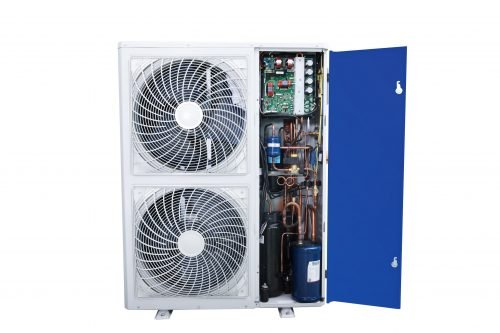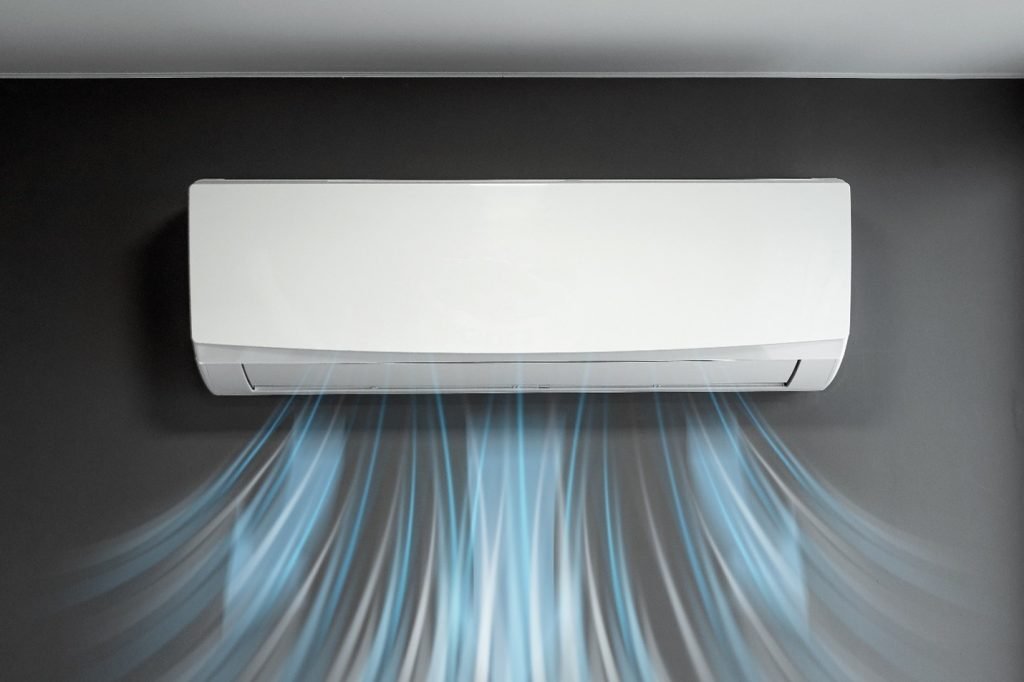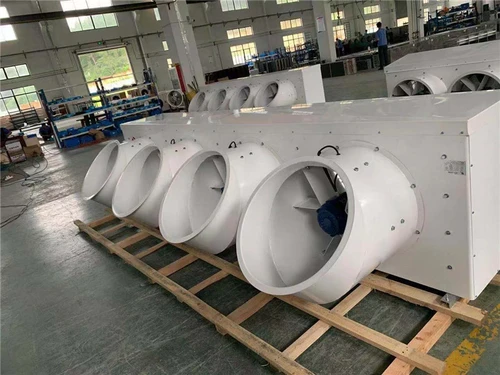Here are the commonly used temperatures for koeleenheden. You need to understand them and pay attention to their differences during daily maintenance.
Discharge Temperature
The discharge temperature (also known as exhaust temperature) of refrigeration unit refers to the temperature of the refrigerant as it exits the compressor. This is a critical parameter in refrigeration systems, as it reflects the thermal state of the refrigerant after compression. Discharge temperature is usually in the range of 50°C~120°C (122°F~248°F).
High discharge temperatures can indicate potential issues such as:
1. Overheating: May damage the compressor or lead to lubricant degradation.
2. Incorrect Refrigerant Level: Too much or too little refrigerant can affect system efficiency.
3. Poor Heat Exchange: Inefficient heat dissipation in the condensator can increase the discharge temperature.
4. High Suction Superheat: Excessive superheat at the compressor inlet may lead to high discharge temperatures.
Compressor Shell Temperature
Compressor shell temperature refers to the outer surface temperature of a compressor’s casing during operation. It is an indicator of the heat generated within the compressor as a result of mechanical work and refrigerant compression.
Key Factors Affect Compressor Shell Temperature
1. Compressor Load: Higher loads can lead to increased internal friction and heat.
2. Omgevingstemperatuur: Surrounding environment can influence the compressor’s cooling efficiency.
3. Refrigerant Feature: The type and condition of the refrigerant affect thermal characteristics of the system.
4. System Efficiency: Issues like poor lubrication, clogged filters, or inadequate cooling can raise the shell temperature.
Normal Ranges: Shell temperature varies by design and system but is lower than discharge temperature. For most systems, shell temperature can range between 40°C ~ 90°C (104°F ~ 194°F). It is important to stay within the manufacturers’ recommended limits to avoid overheating and potential damage to compressor.
Regular monitor shell temperature can help detect early signs of inefficiency or failure in the refrigeration system.

Condensation temperature
Condensation temperature refers to the temperature at which the koelmiddel changes from vapor to liquid status in the condenser during refrigeration cycle. This occurs under a specific pressure, known as condensation pressure, which is determined by the system design and operating conditions.
Condensation Temprature Range
Air-Cooled Condenser
Condensation temperature needs 10°C ~ 15°C (18°F ~ 27°F) higher than ambient temperature.
Bijvoorbeeld, if the ambient temperature is 30°C (86°F), condensation temperature will range from 40°C ~ 45°C (104°F ~ 113°F).
Water-Cooled Condenser
Condensation temperature needs 3°C ~ 8°C (5°F ~ 15°F) higher than inlet water temperature.
Bijvoorbeeld, if the cooling water inlet temperature is 25°C (77°F), condensation temperature will range from 28°C ~ 33°C (82°F ~ 91°F).
Key Points about Condensation Temperature
1. Relation to Heat Rejection: Condensation temperature reflects the point at which refrigerant releases heat to surrounding environment (air or water) in the condenser.

2. System Efficiency: An optimal condensation temperature is crucial for maintaining system efficiency. High condensation temperatures can indicate poor heat transfer or inadequate condenser performance.
Condenser Shell Temperature
Condenser shell temperature refers to the surface temperature of condenser’s casing or outer shell during operation. This temperature indicates how effectively the condenser dissipates heat absorbed from refrigerant into the surrounding environment.
It is usually slightly above the ambient air temperature, ca. 2°C ~ 15°C (4°F ~ 27°F) higher.
Key Points about Condenser Shell Temperature
1. Heat Rejection Indicator: The shell temperature reflects the heat transfer occurring within condenser. It should be lower than the refrigerant’s condensation temperature.
2. Influencing Factors:
Ambient Conditions–Higher ambient air or water temperatures can raise the shell temperature in air-cooled or water-cooled systems.
Condenser Efficiency–Dirt, fouling, or poor airflow can lead to inefficient heat transfer and elevated shell temperatures.
Refrigerant Pressure and Load–Excessive system load or refrigerant pressure can increase internal heat, affect the shell temperature.
Receiver Temperature
Receiver temperature refers to the temperature of refrigerant stored in the liquid receiver of a refrigeration system. Liquid receiver is a vessel located after the condenser, can store and regulate liquid refrigerant supply to the expansion valve or other downstream components.
Key Points About Receiver Temperature
1. Relation to Condensation Temperature
Receiver temperature is close to the condensation temperature since refrigerant in the receiver is in a saturated or subcooled liquid state.
It may be little lower than the condensation temperature if subcooling occurs before the refrigerant enters the receiver.
2. System Operation Indicator
Normal receiver temperatures indicate proper system operation, with sufficient heat removal in the condenser.
Increased temperatures could suggest issues like insufficient condenser cooling or high ambient conditions.

3. Temperatuurbereik
For air-cooled systems, receiver temperature is 5°C ~ 10°C (9°F ~ 18°F) below condensation temperature.
For water-cooled systems, the difference may be smaller due to better cooling efficiency.
Filter Temperature
Filter temperature refers to the temperature of the refrigerant as it passes through the filter or filter-drier in a refrigeration system. Filter-drier is a component used to remove moisture, aarde, and other contaminants from the refrigerant to protect the system and ensure efficient operation.
Key Points About Filter Temperature
1. Refrigerant State
Refrigerant passing through the filter is in a liquid or subcooled state on the high-pressure side of the system.
In some systems, it may also handle vapor refrigerant on the low-pressure side.
2. Normal Temperature Range
The filter temperature should be close to the refrigerant’s subcooled liquid temperature.
It’s 5°C ~ 10°C (9°F ~ 18°F) lower than condensation temperature.
3. Indications of Abnormal Temperature
Temperature drop across the filter may indicate partial blockage caused by dirt, ijs, or debris.
Temperature rise could suggest refrigerant flow issues or an overheated component due to system inefficiencies.
Suction Temperature
Suction temperature (or inlet temperature) refers to refrigerant’s temperature as it enters the compressor through the suction line in a refrigeration system. This temperature is a critical parameter for system performance and compressor health.
Key Points About Suction Temperature
1. Relation to Refrigerant State
Refrigerant is in a superheated vapor state to ensure no liquid refrigerant enters compressor, which could cause damage.
2. Normal Temperature Range
Suction temperature is little higher than evaporator temperature due to the addition of superheat.
Typical superheat values range from 5°C to 15°C (9°F to 27°F).
3. Importance of Monitor
Low Suction Temperature: Indicates insufficient superheat, risking liquid refrigerant entering the compressor ( known as “liquid slugging”).
High Suction Temperature: Suggests excessive superheat, which can reduce system efficiency and overheat the compressor.
TXV Temperature
The temperature associated with a thermostatic expansion valve (TXV) refers to the temperature of the refrigerant or the surrounding area that the valve controls and senses. TXV regulates refrigerant flow into the evaporator based on the superheat of the refrigerant leaving the evaporator.
Key Temperatures in a TXV’s Operation
1. Sensor Temperature
The sensor, attached to the suction line at the evaporator outlet, measures the refrigerant temperature.
This temperature determines the superheat and controls the TXV’s open or close to regulate refrigerant flow.
Normaal gesproken 5°C ~ 15°C (9°F ~ 27°F) above the evaporator’s saturated temperature.

2. Refrigerant Temperature at the TXV Inlet
Refrigerant temperature entering the TXV is the subcooled liquid temperature, which should be little lower than the condensation temperature.
Over het algemeen 5°C ~ 10°C (9°F ~ 18°F) below the condensation temperature.
3. Refrigerant Temperature at the TXV Outlet
After passing through the TXV, the refrigerant’s temperature drops significantly due to expansion, reaching the evaporator’s saturated temperature.
Over het algemeen 5°C ~ 10°C (9°F ~ 18°F) below the condensation temperature.
Evaporation Temperature
Evaporation temperature (also known as the evaporating or saturated temperature) refers to the temperature at which the refrigerant changes from liquid to vapor inside the evaporator of a refrigeration system.
Key Points About Evaporation Temperature
1. Relation to Refrigerant State
At the evaporating temperature, refrigerant absorbs heat from the environment and transitions from liquid to vapor.
2. Determined by Evaporator Pressure
Evaporation temperature corresponds to the saturation temperature at the given pressure inside the evaporator. This relationship depends on the type of refrigerant used.
Temperatuurbereik
Evaporation temperature is usually 5°C ~ 10°C (9°F ~ 18°F) below the target temperature of the medium being cooled (bijv., air or water).
Voor airconditioning systeem, bereik is 2°C ~ 10°C (36°F ~ 50°F).
For low-temperature koelsystemen, it can be as low as -40°C ~ -10°C (-40°F ~ 14°F).
Outdoor Ambient Temperature
Outdoor ambient temperature refers to the temperature outside a building or refrigeration system. It is the external temperature of the environment in which the system operates, and it plays a significant role in the equipment performance like air-cooled condensers or outdoor units of HVAC and koelsystemen.
Key Points About Outdoor Ambient Temperature
1. Impact on Condenser Performance
In air-cooled systems, outdoor ambient temperature directly affects condenser efficiency. A higher ambient temperature can reduce condenser’s ability to reject heat, lead to higher discharge pressures and temperatures.
2. System Load
Outdoor temperature influences the system’s overall cooling load. Bijvoorbeeld, in hot weather, cooling demands are higher, which can affect the performance of koeling and air-conditioning systems.
3. Seasonal Variation
Ambient temperature fluctuates with the seasons, warm in summer and cold in winter. Systems must handle these variations effectively.

4. Normal Temperature Range
Outdoor temperature range can vary greatly depending on geographic location and seasons, but normally, it can range from -10° C (14°F) in winter to +40° C (104°F) or higher during the summer in many regions.
5. Importance in System Sizing and Operation
Engineers consider outdoor ambient temperature when design HVAC and refrigeration systems to ensure they can operate efficiently under both high and low temperature conditions.
Conclusie
These temperatures are influenced by factors such as ambient conditions, system design, refrigerant type,enz.
Proper selection and maintenance the temperatures are crucial for optimizing energy efficiency, ensuring system longevity, and meeting specific cooling or freezing requirements.
Eventuele opmerkingen?
Welkom laat een bericht achter of repost.









